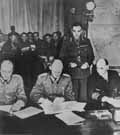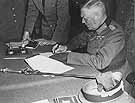
|
|
|

|

|

|

|
|
Click on an image to see a larger, more detailed picture.
|
|
|
|
|
| 1945: Liberation and Rebuilding |

|
pg. 617 |

|
|
|
|
| |
 Walking on makeshift artificial legs, crippled Russian and Polish prisoners accompany an American armored car at Mauthausen. These prisoners had escaped the executions of disabled prisoners that occurred in the last days of the camp. Many were double amputees, with little hope of returning to the lives and jobs they had before the war.
Walking on makeshift artificial legs, crippled Russian and Polish prisoners accompany an American armored car at Mauthausen. These prisoners had escaped the executions of disabled prisoners that occurred in the last days of the camp. Many were double amputees, with little hope of returning to the lives and jobs they had before the war.
Photo: U.S. Army Signal Corps/National Archives
|
 German Colonel General Alfred Jodl (center), Major General Wilhelm Oxenius (left), and Admiral Hans von Friedeburg sign the papers indicating that Germany has surrendered unconditionally. Friedeburg would soon kill himself, and Jodl would be hanged after his conviction by the International Military Tribunal.
German Colonel General Alfred Jodl (center), Major General Wilhelm Oxenius (left), and Admiral Hans von Friedeburg sign the papers indicating that Germany has surrendered unconditionally. Friedeburg would soon kill himself, and Jodl would be hanged after his conviction by the International Military Tribunal.
Photo: SYddeutscher Verlag Bilderdienst
|
 Germany Surrenders
Germany Surrenders
Germany's unconditional surrender on May 8, 1945, marked an ignominious end to the Third Reich. The regime had lasted a mere 12 years, not the one thousand that Hitler had promised. Yet in those 12 years, more than 35 million people had lost their lives because of Nazi aggression. Adolf Hitler committed suicide on April 30, 1945. Admiral Karl Dönitz, Hitler's designated successor, recognized that Germany's situation was hopeless. Thus, on May 7, he sent Field Marshal Alfred Jodl and other senior generals to U.S. General Dwight Eisenhower's headquarters to sign the terms of surrender. Appalled at what he had seen in the concentration camps, Eisenhower refused to accord the enemy the honor of attending the ceremony in person, instead sending emissaries from the British, French, and Soviet armies. A day later, the ceremony was repeated in Berlin, with Soviet General Georgi Zhukov accepting the surrender from German Field Marshal Wilhelm Keitel (pictured). May 8, 1945, has gone down in history as "V-E Day"--Victory in Europe.
Photo: National Archives / United States Holocaust Memorial Museum Photo Archive
|
|

|

|

|

|
 May 1945: Reich Minister of Education Bernhard Rust commits suicide.
May 1945: Reich Minister of Education Bernhard Rust commits suicide.
|
 May 1945: SS-Obergruppenführer Hans-Adolf Prützmann, deeply involved in the September 1941 Babi Yar massacre, commits suicide.
May 1945: SS-Obergruppenführer Hans-Adolf Prützmann, deeply involved in the September 1941 Babi Yar massacre, commits suicide.
|
 May 1945: Martin Luther, the former deputy to Reich Foreign Minister Joachim von Ribbentrop, dies of heart failure.
May 1945: Martin Luther, the former deputy to Reich Foreign Minister Joachim von Ribbentrop, dies of heart failure.
|
 Early May 1945: Martin Bormann, Hitler's influential secretary, is likely killed by Soviet troops as he attempts to flee Berlin on foot. Rumors of his survival will continue for years.
Early May 1945: Martin Bormann, Hitler's influential secretary, is likely killed by Soviet troops as he attempts to flee Berlin on foot. Rumors of his survival will continue for years.
|
 May 1, 1945: Nazi Minister of Propaganda Joseph Goebbels and his wife, Magda, commit suicide in the Führerbunker after fatally poisoning their six children.
May 1, 1945: Nazi Minister of Propaganda Joseph Goebbels and his wife, Magda, commit suicide in the Führerbunker after fatally poisoning their six children.
|
 May 1, 1945: A Jew in a group of laborers from the camp at Sonneberg, Germany, chants and dances with joy upon word of Hitler's death. A German guard calmly shoots the man dead.
May 1, 1945: A Jew in a group of laborers from the camp at Sonneberg, Germany, chants and dances with joy upon word of Hitler's death. A German guard calmly shoots the man dead.
|
 May 1, 1945: The concentration camp at Stutthof, Poland, is liberated by the Red Army. Just 120 inmates remain alive.
May 1, 1945: The concentration camp at Stutthof, Poland, is liberated by the Red Army. Just 120 inmates remain alive.
|
|
|
|
|
| 1945: Liberation and Rebuilding |

|
pg. 617 |

|
|
The Holocaust Chronicle
© 2009 Publications International, Ltd.
|
|
